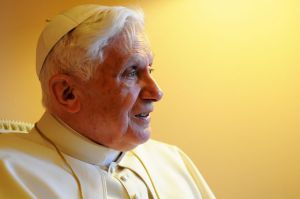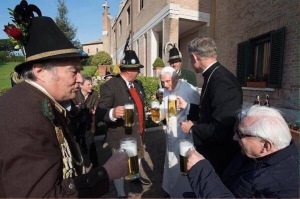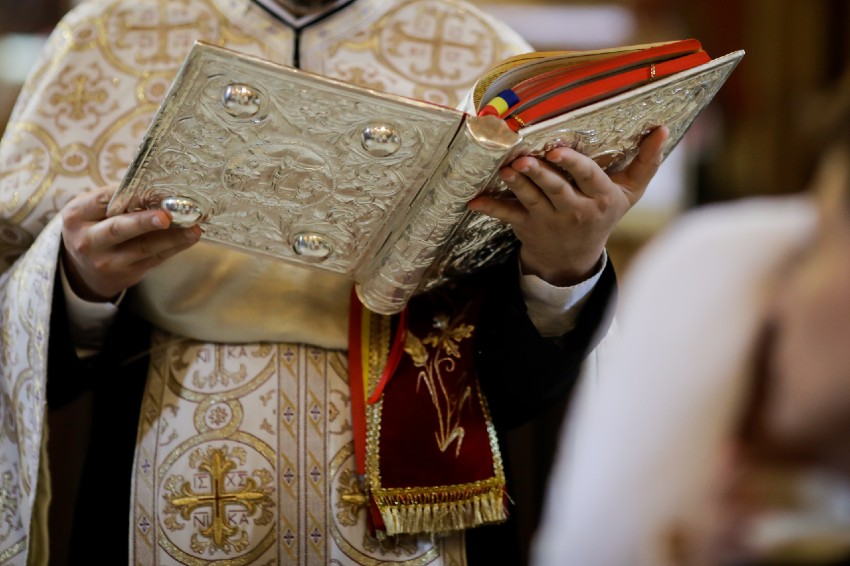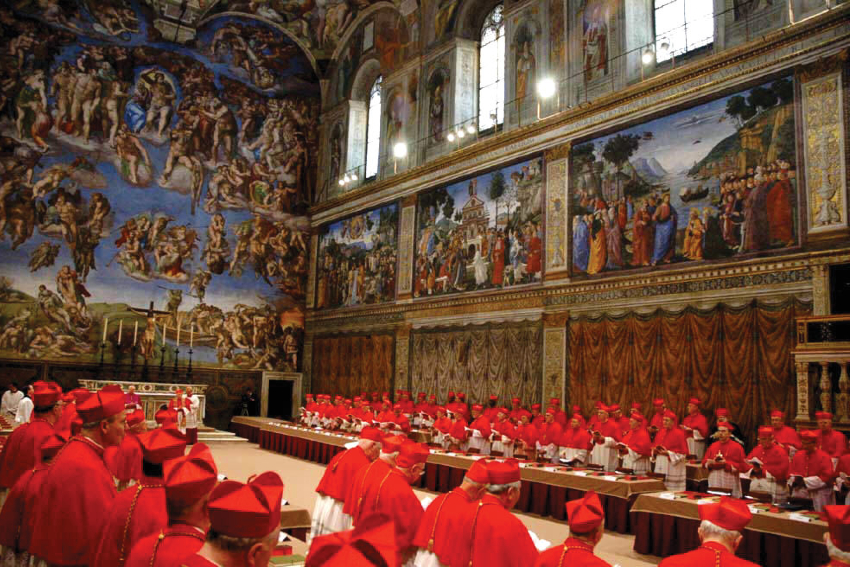April 16, 2015, Thursday — Benedict Turns 88
“Preparing for one’s death means preparing to meet God.” —Archbishop Georg Gaenswein, speaking with an Italian television station this week, on how an elderly Emeritus Pope Benedict is spending his time preparing for death. The Emeritus Pope turned 88 today
Today, April 16, Emeritus Pope Benedict turned 88. (The photo below is from almost 5 years ago, when he was still Pope).
Two years and six weeks ago, when he was 85, just before his 86th birthday, he stepped down from exercising the Petrine office to which he was elected in 2005, on April 19, just days after his 78th birthday.
He served as Pope for just under eight years.
To celebrate his birthday today, he went out of the Vatican to Castel Gandolfo, a palace a few miles outside of Rome that has traditionally been the summer residence of the Popes. (However, Pope Francis has decided not to use it, and has remained in the Domus Santa Marta even during the hot days of July and August during his first two summers as Pope.)
The Vatican newspaper, the Osservatore Romano, released photos of the birthday celebration earlier today.
Above, Emeritus Pope Benedict XVI, dressed in white, is joined by his older brother, Monsignor Georg Ratzinger (seated at the lower right) — Monsignor Georg normally lives in Regensburg, Germany — and by his personal secretary, Archbishop Georg Gaenswein, who is standing between the two brothers, looking toward the Emeritus Pope. Also present are a group of Bavarians. The gathering is in the gardens of the papal residence at Castel Gandolfo.
Pope Francis celebrated Mass in Benedict’s honor Thursday morning, saying he hopes God “supports him and gives him much joy and happiness.”
In recent interviews on the eve of the birthday, Benedict’s secretary, Archbishop Gaenswein, said the Emeritus Pope feels his age and thinks about his own mortality.
“The Emeritus Pope thinks about death and is preparing for his death,” Gaenswein said in an interview with Mediaset television this week. “It’s a Christian art, because preparing for one’s death means preparing to meet God.”
Two years ago, Ratzinger became the first Pope in 600 years to step down, saying he did not have the strength of body or spirit to carry on.
Gaenswein this week told the Rome-based La Repubblica newspaper that he tried to convince Benedict to stay, but that the Pope’s decision was firm.
Benedict spends his time reading and keeping up with his correspondence. He also receives occasional guests. He is not planning to do any more writing, Gaenswein says.
“He told me ‘Jesus of Nazareth is my last book,'” Gaenswein said. Benedict’s three-volume work on Christ’s life was released during his pontificate.
In February, at the time of the second anniversary of Benedict’s resignation, his personal secretary gave an interview to the Milan-based Corriere della Sera.
Benedict XVI never doubted or regretted his decision to resign, knowing it was the right thing to do for the good of the church, Archbishop Georg Gaenswein, prefect of the papal household and personal secretary to the retired pope, told the newspaper.
“The Church needs a strong helmsman,” and Pope Benedict was keenly aware of his own waning strength while faced with such a demanding ministry, the archbishop said.
Two years after Pope Benedict’s historic announcement Wednesday to step down as supreme pontiff, Gaenswein said the retired pope “is convinced that the decision he made and announced was the right one. He has no doubt.”
“He is very serene and certain in this: His decision was necessary and made ‘after having repeatedly examined my conscience before God,'” he said, citing words from the Pope’s February 11, 2013, announcement.
Pope Benedict had told a stunned audience of cardinals assembled for an ordinary public consistory that “I have come to the certainty that my strengths, due to an advanced age, are no longer suited to an adequate exercise of the Petrine ministry.”
Gaenswein said in the interview that Pope Benedict was aware of his “duty not to look out for his own self but for the good of the Church.”
The Pope spelled out the precise reasons for his decision, the archbishop said, and “all the other considerations and hypotheses are wrong,” including assumptions that the pope’s resignation was not valid or had not been done in full freedom.
“Hypotheses cannot be based on things that are not true and totally absurd,” Gaenswein said. “Benedict himself said he made his decision with freedom, without any pressure, and he assured his ‘reverence and obedience’ to the new Pope.”
The option for a Pope to resign is explicitly written in the Code of Canon Law, he noted. The code says a Pope may step down as long as the decision is made freely and is “duly manifested.”
Like his namesake, St. Benedict — the father of Western monasticism — the retired Pope “has chosen a monastic life. He goes out [in public] only when Pope Francis asks him to; as for the rest, he does not accept other invitations,” the archbishop said.
Gaenswein told the newspaper that in addition to the Pope’s usual routine of prayer, reading, keeping up with correspondence, receiving visitors, watching the evening news and walking in the Vatican Gardens, he has been playing the piano much more often: “Mozart especially, but also other compositions that come to mind at the moment; he plays from memory.”
The only health issues, the archbishop said, are “every now and then his legs give him some problems, that’s all.” The Pope, who has had a pacemaker for several years and uses a cane, still has an incredibly sharp mind, he added.
When asked what Popes Benedict and Francis might have in common, Gaenswein said while their ways of expression are very different, the one thing they share is “the substance, the content, the deposit of faith to be proclaimed, promoted and defended.”
In March, on the second anniversary of Pope Francis’ election, Archbishop Gaenswein gave another interview, to the popular Italian magazine Oggi. He spoke about Pope Francis’ Pontificate, Benedict XVI’s health, and the “Vatileaks” affair. On March 18, 2015, Deborah Castellano Lubov published the following summary of the interview for the Zenit news agency:
On Pope Francis
Archbishop Gaenswein reflected on Pope Francis’ ability to always “surprise.”
“With the announcement of the extraordinary Holy Year, Pope Francis gave another proof of his ability to surprise,” he said.
Asked how the Pope is up close, he replied: “The personal perception and the perception of the media coincide. Pope Francis is an authentic person. He is how he looks to the viewer from a distance or on TV… I’m surprised by his ability to manage having always so many events, general and private audiences, personal meetings, etc.”
“At age 78, Pope Francis tackles everything with extraordinary strength.”
He also reflected on the obstacles in the path of Church reform. “Of course, there are those who may not have his vision,” he said, “but it cannot be said that Pope Francis is hampered or thwarted. The challenge of the missionary Church is the main theme of his pontificate,” he said.
The Vatican official noted the Curia is working on economic and financial issues, but it takes patience and time. “A large ship cannot change course in a short time, it is not a small boat.”
The archbishop also responded to Pope Francis’ statements which have caused media waves, such as giving a “punch” to those who offend or parents giving a child “a spanking.” He admitted that, “In the Anglo-Saxon and German world, he has created a heated discussion, even one which is a little ‘exaggerated.’”
“You have to contextualize his words and steer them in his direct communication style,” he said, “especially when he speaks off the cuff. He likes to speak in a clear and open way.”
“Maybe, after certain reactions, which may also depend on the sensitivity of different peoples and countries, he could change gears.”
On Pope Benedict
Archbishop Gaenswein also reflected on Pope Emeritus Benedict XVI, for whom he has been secretary since 2003. He remembered crying when Pope Emeritus left the Apostolic Palace in Castel Gandolfo, after resigning.
“I was moved,” he said. “After eight years there as a secretary, I was living a historic moment. Instead, Pope Benedict was serene.” That evening of February 28, he reflected, he had withheld his emotions, until they became tears.
The German archbishop also spoke of how the Pope Emeritus passes his days.
“He’s fine, for his age,” he reflected, noting he makes afternoon stroll daily in the Vatican Gardens.
“I usually go with him. We recite the Rosary together. We walk [30 minutes]. Pope Benedict, who has always had a brisk pace, now, on the advice of the doctor, uses a walker, and a cane in the house. The days always start with Mass, and I concelebrate with him every morning. During the day, he reads, studies, answers many letters and, not infrequently, in the evening, he plays the piano.”
“With the three volumes on Jesus of Nazareth, he ended his theological work,” he noted.
“He [Pope Benedict] says he has no more strength to write.” he noted. Yet, he said during Sunday Mass, the Pope Emeritus always gives the homily, without written notes. “He has a good memory.”
On His Own Role
The prefect also reflected on his unprecedented role, the first prelate to be a collaborator to two Popes.
“I started this journey with great faith, energy, but also a bit of fear. Now, after two years, it is easier. At first, I was more insecure… The attitude of welcoming (by) Pope Benedict XVI to Francis was, and is, exemplary. Between the two, there really is a very friendly and respectful relationship,” he said.
On the “Vatileaks” Affair
Remembering the Vatileaks scandal, the archbishop called it a difficult period in which he experienced disappointment and felt betrayed. Yet, he noted, how Pope Benedict has always had confidence in him.
“I felt, in a sense, responsible for not having adequately supervised, for giving confidence to those who did not deserve it.” He said. “Of course, even among the Apostles, there were those who betrayed him [Jesus]. But when I realized that the person doing so was a person so close to the Pope, I was very shocked … When I look back, I feel sorry in my heart.”
Just today, journalist Elise Harris, writing for Catholic News Agency, has published an interesting piece in which she argues that the origins of Pope Francis’ Jubilee of Mercy can be found in the pontificate of Emeritus Pope Benedict. She cites Archbishop Rino Fisichella, whose Council for the New Evangelization is responsible for many of the preparations for the Jubilee. Below are excerpts from her complete piece (link):
On 88th birthday, Benedict XVI lauded for emphasis on mercy
By Elise Harris
Rome, Italy, Apr 16, 2015 (CNA/EWTN News) — The Vatican official charged with organizing the upcoming Jubilee for Mercy says the topic was the “heart” of Benedict XVI’s pontificate, due to the emphasis he placed on love, which is lived out in mercy.
“We cannot forget that Pope Benedict, his first encyclical was Deus Caritas Est (God is Love). That means the center, the heart of his pontificate was put in the light of love, and love and mercy are the essential for the Church,” Archbishop Rino Fisichella told CNA April 13.
Love, he said, “is mercy (and) mercy is love reaching pardon. We cannot forget the beginning of the encyclical Deus Caritas Est: love is not an idea, love is a person and it means also to meet, to encounter a person.”
Archbishop Fisichella, prefect of the Pontifical Council for the New Evangelization, is responsible for organizing the upcoming Extraordinary Jubilee for Mercy.
Announced by Pope Francis March 13, which marked the second anniversary of his pontifical election, the Holy Year will open this year December 8 – the Solemnity of the Immaculate Conception – and will close Nov. 20, 2016, with the Solemnity of Our Lord Jesus Christ, King of the Universe.
Pope Francis released the Bull of Indiction of the Extraordinary Jubilee Year of Mercy April 11, moments before presiding over Vespers in St. Peter’s Basilica for the vigil of Divine Mercy Sunday. The title of the bull is Misericordiae Vultus – or, “The Face of Mercy.”
For Benedict XVI, “the face of mercy, (is) the face of the encounter with Christ,” Archbishop Fisichella said…
In the introduction of his encyclical on love, the now-retired pontiff explained that to be a Christian “is not the result of an ethical choice or a lofty idea, but the encounter with an event, a person, which gives life a new horizon and a decisive direction.”
God is the one who took the initiative, and first loved us by giving his only Son so that “whoever believes in him should… have eternal life,” Benedict wrote in the encyclical…
Archbishop Fisichella referred to the title of the papal bull for the Jubilee on Mercy, saying that it comes from the same idea expressed in Benedict XVI’s encyclical; that mercy is a person, not just a mere concept or idea.
“We should remember that the face is not just something physical. When we speak about (a) face, we speak about what we are,” he said.
“No one can change his face because we are our face, and I think that ‘face’ also means our emotion, our feelings, everything we are is expressed by our face. For this reason, the face of mercy is Jesus Christ, the words of Jesus Christ, the deeds Jesus Christ. (This whole) person is in concrete mercy.”
Benedict XVI also spoke of mercy as both the name and face of God in his Regina Coeli address on Divine Mercy Sunday in March 2008, saying that it constitutes the “central nucleus” of the Gospel message.
Mercy, he said in the speech, “is the very name of God, the Face with which he revealed himself in the Old Covenant and fully in Jesus Christ, the incarnation of creative and redemptive love.”…
The Face of Mary in Absam
One final reflection.
It is relatively little known that an unexplained, seemingly miraculous image of the face of the Virgin Mary, which appeared 300 years ago in the village of Absam, Austria, just outside of Innsbruck, and not far from the village of Gnadenwald (“Mercywood”), has a connection with the life of Joseph Ratzinger, that is, with Emeritus Pope Benedict.
The mysterious image appeared suddenly in 1797.
The local parish priest at first treated it as a troublesome hoax. He allowed his assistants to scrub it off. But the scrubbing had no effect.
The image remained — and is still visible to this day.
Let us read what Johann Puecher, wrote about what happened in 1797 in their father’s house. At the age of 76, he wrote the following in the presence of two witnesses:
“On 17th January 1797, my sister, a grown girl (18 years of age) by the name of Rosina was sitting at the table by the window on the ground-floor room sewing. She then — between 3 and 4 o’clock — suddenly looked up and saw what had never been seen before, drawn on a window pane, an image of Mary, the Mother of God. She called to her mother, who was also present, but in another part of the room. Mother hurried over and was initially not a little frightened, when she saw the image of the Holy Virgin, as she thought an accident could have befallen father or myself in the salt-mine where we worked. She said to sister Rosina that we should pray; and that is what happened. After saying their prayers, the mother wiped the picture with a cloth, because she thought it was steamed up, but look, scarcely had she wiped it off, but it was back just as it was before. The apparition of the image took place on a Tuesday, and on the Thursday me and my father came home perfectly well from the mountain. We looked with joy and amazement at what we had occurred. On 17th January 1797 I was in my 16th year and have retained in my memory everything that happened on that day.”
The church in Absam has become a place of Marian pilgrimage.
The connection with the Emeritus Pope is this: his grandparents chose to celebrate their marriages in the church, in Absam, where this miraculous image of Mary is preserved.
His grandparents, Maria Tauber-Peintner and Isidor Rieger, were married in that church on July 13, 1885.
In this sense, the family and human origins of the Emeritus Pope intersect, in a mysterious way, with the church where an image of the face of the Mother of God appeared, in a town not far from Gnadenwald (“Mercywood”).
Note: For those who would like to travel with us on pilgrimage:
(1) In mid-July 2015, we will travel with a small group of Inside the Vatican readers on our annual “Urbi et Orbi” pilgrimage to Russia, Turkey and the Vatican, to visit eastern Orthodox leaders, shrines and monasteries, and to talk with Vatican officials about ecumenical relations between Catholics and Orthodox;
(2) On December 8, 2015, and again on November 20, 2016, we will be gathering in Rome to be present when Pope Francis opens the Holy Door to begin his Special Jubilee of Mercy, and when he closes the door to end the Jubilee Year. If you would like to join us on one or more of these pilgrimages, email now for more information…
We keep all of these pilgrimages small. Please contact us if you would like your name to be placed on a waiting list, to hold your spot.
Also, if you have not yet subscribed to the magazine, please do so now. Every subscriber is important to us. To subscribe, click here:
What is the glory of God?
“The glory of God is man alive; but the life of man is the vision of God.” —St. Irenaeus of Lyons, in the territory of France, in his great work Against All Heresies, written c. 180 A.D.










Facebook Comments